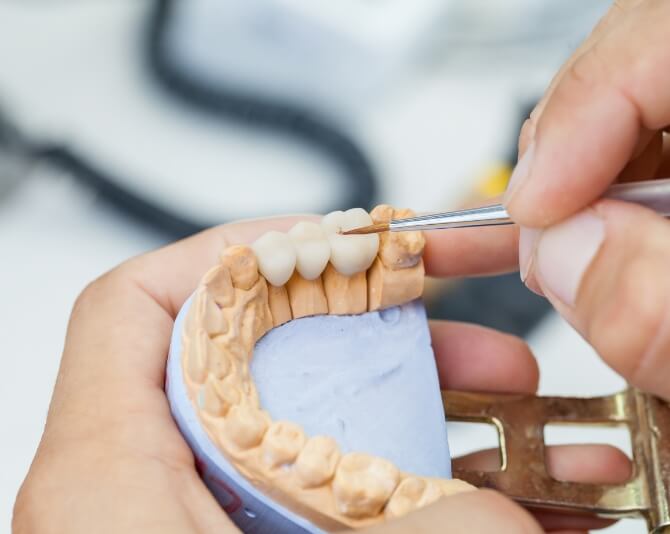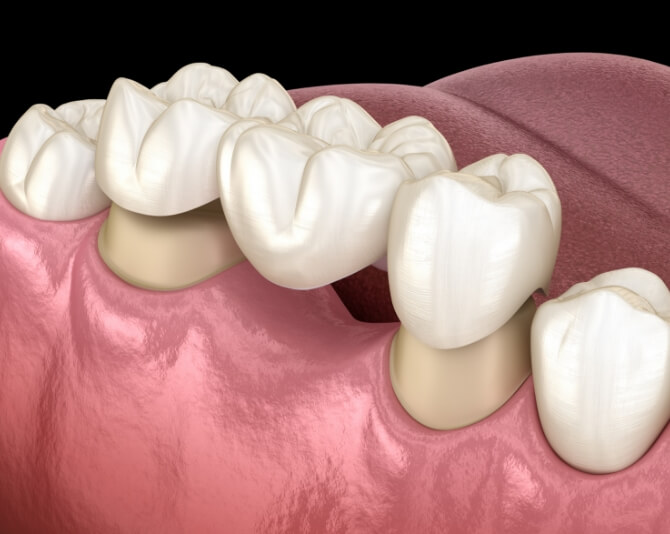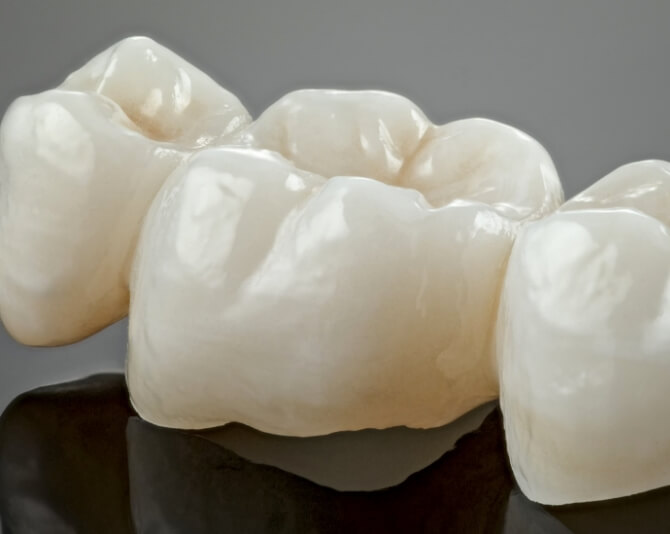Dental Bridges Edison
Strong and Reliable Tooth Replacement

For patients who are missing one or more teeth in a row, there are a few different ways to fill in the gap. A dental bridge in Edison is one of those options. As a highly trained prosthodontist, Dr. Shah is capable of designing top-quality bridges that are sturdy, aesthetically pleasing, and built to stand the test of time. If you are interested in learning more about this treatment or in scheduling a consultation, get in touch with Edison Prosthodontics today. We look forward to serving you!
Why Choose Edison Prosthodontics for Dental Bridges?
- Advanced Dental Technology
- Highly Trained Prosthodontic Specialist
- Friendly & Empathetic Team
What Is a Dental Bridge?

As its name implies, a dental bridge is meant to “bridge” the gap between the remaining natural teeth. There are a few different types of dental bridges, but typically, they rely on the support of the abutment teeth (teeth next to the empty space) to stay in place. Bridges can be made out of various materials, but porcelain and ceramic are the most popular choices due to their natural appearance. In most cases, bridges are capable of replacing 1-4 missing teeth in a row.
Types of Dental Bridges

“Dental bridge” is a general term that can be applied to a few different specific types of tooth replacement options. When you visit us for a consultation, your dentist in Edison will examine your mouth, learn about your circumstances, and then recommend the type of bridge that would work well for you.
Our team may tell you that one of the following would be the best way to recomplete your smile.
Traditional Bridge

A traditional fixed bridge is composed of two crowns, which get attached to the abutment teeth on each side of a gap in the mouth. One or more pontics (artificial teeth) are supported by the crowns. Maryland bonded bridges, which are attached to the adjacent teeth by small wings, are a more conservative option. There are also cantilever bridges, which are attached to only one abutment tooth rather than two.
Traditional bridges tend to be sturdy, long-lasting, and pleasing to the eyes.
Implant Bridge

Rather than relying on nearby teeth for support, an implant bridge is supported by prosthetic tooth roots (dental implants). Unlike traditional bridges, this type of restoration does not require that the nearby teeth be altered in any way. Plus, dental implants can stimulate the jawbone and help to keep it strong and whole.
The Benefits of Dental Bridges

Some of the benefits that patients can experience with a dental bridge include:
- No dental drift. Without a restoration to fill in the empty space in your smile, your remaining natural teeth could drift out of place. A bridge prevents this issue.
- Increased confidence. Missing teeth may cause a degree of self-consciousness for many people. Bridges look natural and can allow you to smile with confidence.
- Improved ability to eat and speak. A full set of teeth allows you to enjoy optimal oral function.
Do you believe you could benefit from a dental bridge? Schedule a consultation with Dr. Shah and our team today!
Dental Bridges FAQs
Can You Take a Dental Bridge Out?
No. Dental bridges are made to stay anchored to your natural teeth at all times. You won’t be able to take them out on your own; only your dentist will remove them, and they’ll only do so for oral health purposes.
Some people might be confused because they’ve heard healthcare providers in the past talk about “removable bridges”, but the restorations they’re talking about aren’t actually bridges. They’re really referring to partial dentures that can be designed to replace multiple teeth throughout your mouth. Partial dentures are made to be taken out of your mouth at any time, whereas traditional bridges are not.
Is Getting a Dental Bridge Painful?
To place a dental bridge, we need to remove some enamel from the teeth adjacent to the gap. During this process, we’ll numb the area of your mouth in question so that you don’t experience any discomfort. After your teeth have been prepared and the bridge has been placed, you’ll probably experience some sensitivity, but over-the-counter pain medicine will be enough to keep it under control.
Getting a bridge now could potentially save you from dental discomfort in the future. By filling the space in your smile, you’ll prevent your remaining teeth from drifting out of place. This means you won’t have to deal with the pain and dental damage that can be caused by misaligned teeth.
Do Dental Bridges Look Natural?
Like crowns, bridges can be made out of many different materials, including tooth-colored options like porcelain and ceramic. As such, we can provide dental bridges that closely match the rest of your smile, right down to the color and the way they reflect light. Most people won’t be able to tell the difference between a dental bridge and your natural teeth – especially since, unlike dentures that might slip at awkward times, bridges are made to stay firmly in place.
Can Dental Bridges Get Cavities?
Dental bridges cannot develop cavities, but the teeth that support them definitely can. Food debris and bacteria can become trapped under the pontics or in the space between the crowns and the gums; if this happens, you could eventually suffer from tooth decay.
It’s important to clean underneath your dental bridge to stop harmful bacteria and substances from accumulating where they can do the most damage. Keep in mind that with older dental bridges, the cement holding them in place may eventually crack and provide an opening for bacteria; if you notice any such cracks, you should let us know immediately so that we can address the damage.
How Long Should a Dental Bridge Last?
A dental bridge that receives excellent care may last between five and fifteen years, but this can vary based on what material the bridge is crafted from. While metal bridges can last longer than metal-free ones, the difference is often negligible. Bridges that replace the front teeth may last longer than those replacing the back teeth since they endure less pressure during the chewing process. The most important factor in how long your bridge can last is how well you take care of it with proper hygiene, smart eating decisions, and regular dental appointments. Bad habits like smoking, excessive alcohol consumption, and using your teeth to chew on inedible objects or open packaging are great ways to damage your dental restorations and natural teeth, so it’s best to kick them. A bridge supported by dental implants may be able to last much longer than a traditional bridge, and while the restoration will eventually have to be replaced, the titanium pieces supporting it can last for decades if they receive excellent care.
How Many Teeth Can a Dental Bridge Replace?
A dental bridge can replace up to four consecutive missing teeth, but these devices usually only replace one or two. Longer bridges are less stable, so supporting them can be risky for the healthy teeth on either side of the gap. Supporting a bridge with dental implants can increase the stability of longer appliances since implants are comparable in strength to natural teeth.



